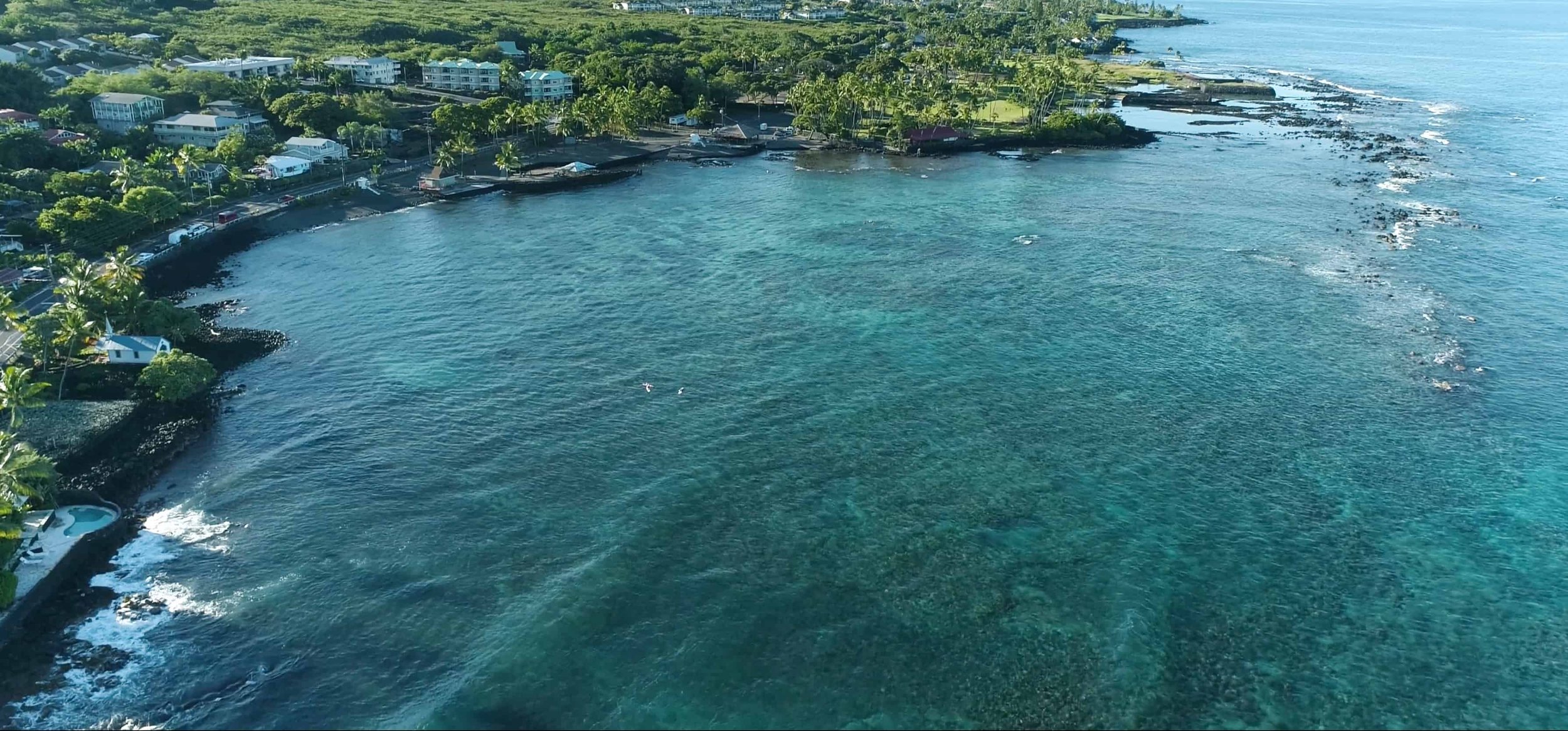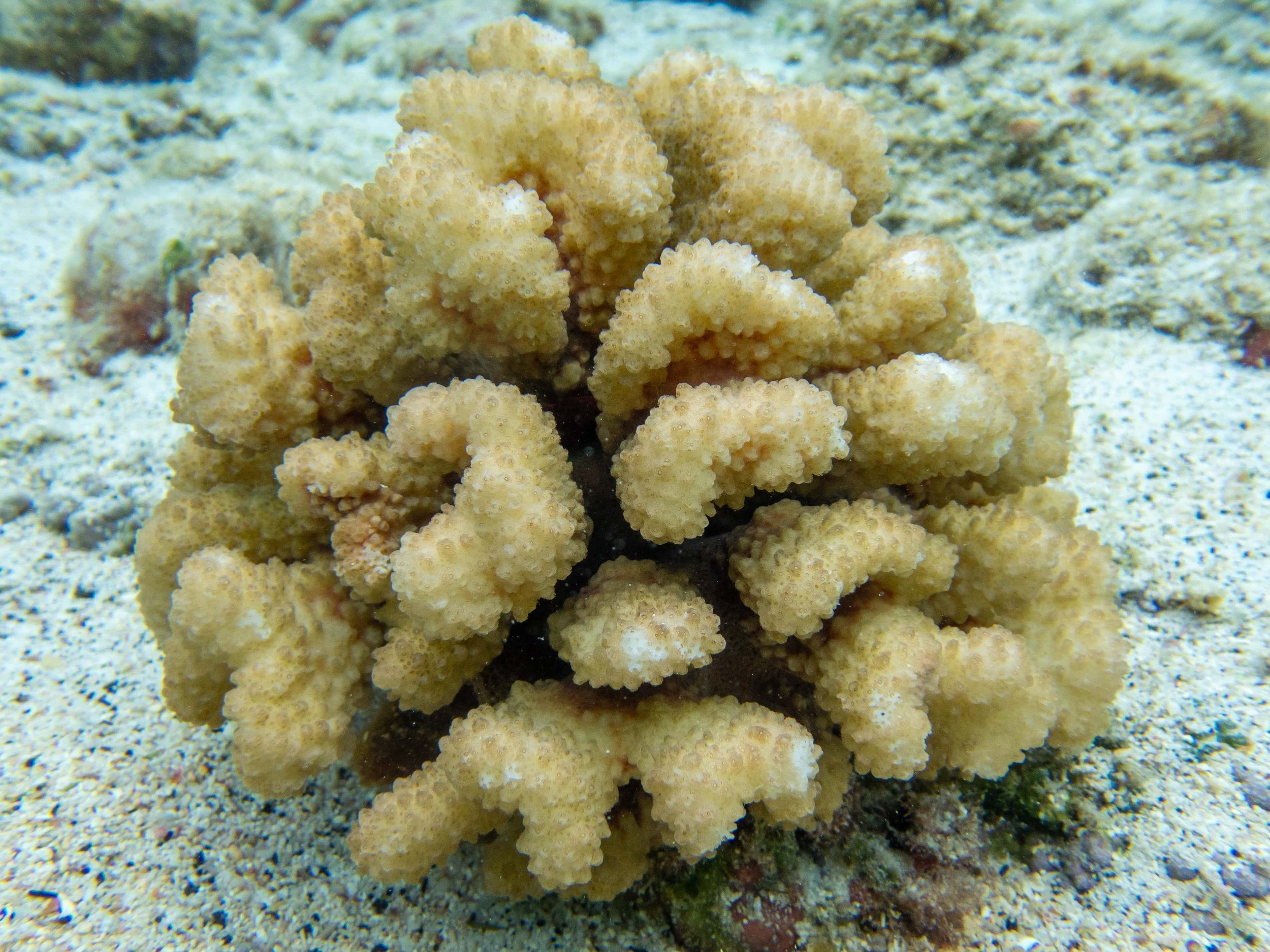The Digital Coral Ark

KAHALUʻU BAY, HAWAIʻI
The first project in the Digital Coral Ark initiative is Kahaluʻu Bay on Hawaiʻi Island, a small but important reef that is under significant and continued threat of degradation from multiple factors. Kahaluʻu is known as ʻAina Lei Aliʻi - lands that adorn the chiefs. It is a wahi pana, a sacred, celebrated, and storied place embraced by the cultural customs of Hawaiʻi. Kahaluʻu is home to significant cultural sites, contains a unique intertidal system, and features an important coral reef with a diverse array of marine life.
Easily accessible to the public, Kahaluʻu Bay and Beach Park is featured in almost every visitor’s guide as one of the best snorkel spots in the Hawaiian Islands due to the clear shallow water and abundant tropical reef fishes, as well as the charismatic, threatened honu (green sea turtles).
Green Sea Turtle - Kahaluʻu Bay
STRESSORS
Unfortunately, these assets have led to Kahaluʻu Bay (which is only 4.2 acres) being “loved to death” annually by over 400,000 visitors.
Worse, there are additional significant synergistic stressors to the bay as well, meaning that their combined effects are greater than the sum of their individual effects. These stressors are negatively impacting both marine and human life that rely on the bay and include:
Overcrowding & Coral Trampling: Because of its high volume of visitors compared to its size (over 400,000 visitors/year) and its ready accessibility, the coral reef is subject to trampling by those who are unaware of the sensitive nature of the ecosystem. During low tides, snorkelers and swimmers often stand, kick, and walk on coral as they are unable to differentiate live coral from rock. During high tides, snorkelers routinely kick up sediment with their flippers, which suffocates the delicate corals in the bay.
Coastal Inundation: Coastal development mauka (upslope) from the bay has increased bacteria, nitrogen, phosphorus, ammonia and other chemical levels in the bay’s waters. All of these stressors reduce the bay’s resilience to climate change effects, including storm surges and sea level rise which erode the beach area and compromise habitat preservation areas for sea turtles, monk seals, birds, fish, and native marine plants.
Impaired Water Quality, Sewage & Runoff: Human and animal waste, fertilizer, pesticides, and other land based sources of pollution enter the bay daily through submarine groundwater discharge and shoreline springs-- evidence of which is reflected in the water quality testing for nutrient levels. Oxybenzone concentrations were once measured over 262 times higher than EPA threshold. Many corals have seen documented decline in the absence of bleaching events.
Climate Change: Climate change is leading to increased frequency and intensity of thermal stress events and ongoing sea-level rise. It is important for island communities to develop policies and implement strategies that reduce vulnerability to natural hazards. Poor water quality makes corals less resilient to thermal stress.
WHY IT’S IMPORTANT
Kahaluʻu Bay is vital to the broader reef and ocean ecosystems on the West Coast of Hawaiʻi Island. This region contains one of the state’s longest contiguous coral reefs, supporting an abundance of species including corals and fish, of which nearly a quarter are found nowhere else in the world. The area is home to several endangered or threatened species, such as ʻIlio holo i ka uaua (Hawaiian Monk seals), Koholā (Humpback whales), and Honu (Green) and Honuʻea (Hawksbill) turtles. Additionally, as a shallow, protected coral reef, Kahaluʻu Bay naturally acts as a marine nursery that replenishes other fisheries along the coastline.
Multiple Juvenile Fish Species Sheltering in Kahaluʻu Bay c. 2012. Image donated to the Digital Coral Ark historical collection by Richard Hart.
One profoundly important species is Hawaiʻi’s native cauliflower coral (Pocillopora meandrina). Cauliflower coral provides safety and habitat to many forms of marine life, and serves as nursery for an endemic fish species found nowhere else in the world— the Dascyllus albisella, commonly known as the Hawaiian dascyllus or Hawaiian domino damselfish. Because of its importance in the ecosystem, cauliflower coral was petitioned to be considered as a threatened or endangered species by the Center for Biological Diversity in 2018, though this petition was not successful (Notice by the National Oceanic and Atmospheric Administration on 07/06/2020).
WHERE WE ARE NOW
Unfortunately, our own rough estimation is that the number of living cauliflower coral colonies in Kahaluʻu Bay has declined by upwards of 90% in recent years, due in part to the coral bleaching events of 2014 and 2015, but likely also from other synergistic stressor such as land-based pollution, sewage, sunblock and other personal care product chemicals in the water, sedimentation, and/or physical disturbance caused by human trampling. Here is a 17-month sequence captured from our footage showing one of the remaining living cauliflower coral colonies that survived the 2015 bleaching event in the bay:
This coral colony, Canary, died completely by January 2020. Unfortunately, our little Canary was not the only casualty in the past few years— this next timeline features a coral we named Compadre because it sat next to a coral named Spawner, who provided the only gametes collected in the bay in 2018.
This next coral colony was particularly special to us, with a little arc-eye hawkfish always residing safe and protected within its hospitable deep folds (with a good eye, you can spot it in four of the photos below). It was beyond distressing to see significant tissue death and algal growth in July of 2019. Without the protection of cauliflower coral colonies, many fish will be unable to survive and reproduce.
Sadly, Rassy has since died and now blends into the rock that once supported a vibrant ecosystem. We haven’t seen the little hawkfish since.
Rassy - May 12, 2022
Thus, it becomes particularly important to gather and organize as much footage as possible in the face of ongoing degradation of the reefs.
It’s not surprising that this reef has declined to a shadow of its former majestic beauty. What’s miraculous is that coral life continues in Kahaluʻu Bay despite extreme and synergistic stressors. This is in large part due to the efforts of the Kahaluʻu Bay Education Center (KBEC), who have worked tirelessly to mitigate the human-impact damage to the bay.
Thanks to the conservation efforts of KBEC, there are also bright rays of hope in the bay. For instance, during the Covid pandemic, Kahaluʻu Bay had an opportunity to rest and restore itself, as evidenced by observed improvement of water clarity and increased fish abundance— including sightings of rare and endangered species. And, through government-community partnerships initiated by KBEC, closures of the bay during cauliflower coral spawning season are giving new life a fighting chance each spring.
WHERE WE WANT TO GO
With continued effort and a little luck, we hope that the Digital Coral Ark project will contain community photo/video contributions, not only the historical degradation of the bay, but also healing and revitalization evidenced by young cauliflower coral colonies growing in the years ahead, such as this one photographed in Kahaluʻu Bay on May 12, 2022.
CONTRIBUTE
If you would like to contribute to the Kahaluʻu Bay pilot project, there are several ways to help:
Check out our volunteer page for the opportunities available.
Donate to the cause.
Contribute historical footage of Kahaluʻu Bay. We are especially interested in images or footage taken prior to 2016.
Contact KBEC to volunteer with ongoing data collection.
Feel free to contact us here if you have any questions!
Image Credits & References
Image Credits
The original images in the timeline series of the cauliflower corals were donated to Dear Ocean by Silver Spiral Seas, LLC. Later images are copyright of Dear Ocean. Please contact us here for terms of image usage.
Juvenile fish and coral image donated to the Digital Coral Ark historical collection by Richard Hart.
References & Further Reading
https://www.biologicaldiversity.org/species/invertebrates/monarch_butterfly/pdfs/Petition-to-list-Pocillopora-meandrina-under-the-ESA_031418.pdf
http://kohalacenter.org/kbec/etiquette
https://www.federalregister.gov/agencies/national-oceanic-and-atmospheric-administration
https://www.marinelifephotography.com
http://www.hawaiisfishes.com/books.htm







